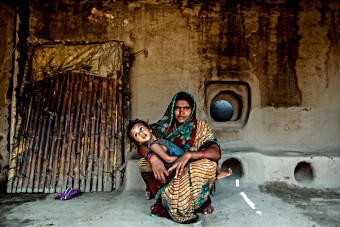Why girls are stronger than boys but need more protection

Maya Devi holds her two-and-a-half year old son, Luvkush, outside their home in Purani Panapur in the Patna district of Bihar. Credit: Gavi/2013/Manpreet Romana.
11 October 2018 - Nature has been generous to endow women with a biological advantage over men. Research shows that they have more robust immune systems and are less at risk of congenital disease, giving them a survival advantage in the early years when children are most at risk of dying from infectious diseases. Therefore one would expect more girls than boys to reach their fifth birthday, and indeed this is the case in most countries across the world. But there is a notable exception: my home country India.
A report released by UNICEF last month showed that since 1990, under-five mortality has more than halved globally. However, in many countries, mortality rates for girls have not fallen in line with this. This is particularly true in India. Mortality rate for girls under-five is higher than would be expected in 29 out of 35 states, and the four largest states in northern India (Uttar Pradesh, Bihar, Rajasthan, and Madhya Pradesh) account for two-thirds of India's total number.
Nature nurture
This is because the biological advantage that girls are born with can quickly be eroded by the environment that they are growing up in, as a result of the multiple disadvantages they face from birth into early childhood and beyond. A recent study reported that 230,000 girls in India die every year as a result of gender-specific neglect. In some households, girls may be not be as well-fed as their brothers, less educated and even denied medical attention when they get sick. The effect of this is more pronounced for girls who are younger siblings, particularly if they have elder sisters. If a family has limited resources, many parents will focus those resources on their sons.
Rukhsar Khatoon, the last person to contract wild poliovirus in India, did not receive the vaccine even though her siblings did. This is not an uncommon narrative. In Kolkata, 12% of first-born sons do not complete their immunisation on time, but this proportion is more than double for second-born daughters at 28%.
Vaccines redress the balance
A huge cultural shift would be needed to change the deep-seated mind-sets and behaviours that value a son more than a daughter. In the meantime, vaccines provide an invaluable opportunity to start redressing the imbalance.
Firstly, vaccines are offered as a free-of-charge service by the national immunisation programme, removing the resource-allocation dilemma in getting one’s daughter vaccinated. They protect girls against some of the most common infectious diseases that kills children at that age, such as measles, diarrhoea and pneumonia, and remove the need for girls to receive medical care.
But even beyond protecting their health in the present, vaccinations are an investment in girls’ futures. Vaccines such as the hepatitis B vaccine and the HPV vaccine protect girls against cancers that could affect them later in life, and healthy girls have a greater chance of attending school. More educated girls are also more likely to vaccinate their own children, setting in motion a positive feedback loop that helps protect the health of future generations.
In India, we do still face the issue of more boys being vaccinated than girls. But we have achieved gender equity in vaccination at the global level – an impressive feat considering the huge gender imbalances we still see in many other aspects of women’s lives, even in the most developed countries in the world.
Now, on the Day of the Girl Child, we need to zoom in and take a closer look at the issue within countries and within districts. In areas with particularly strong male preference, every baby girl will have a fight ahead of her when it comes to getting access to early childhood care, getting an education, competing for jobs and having her voice heard in her family and in her community. Let’s start this fight by protecting her health.
